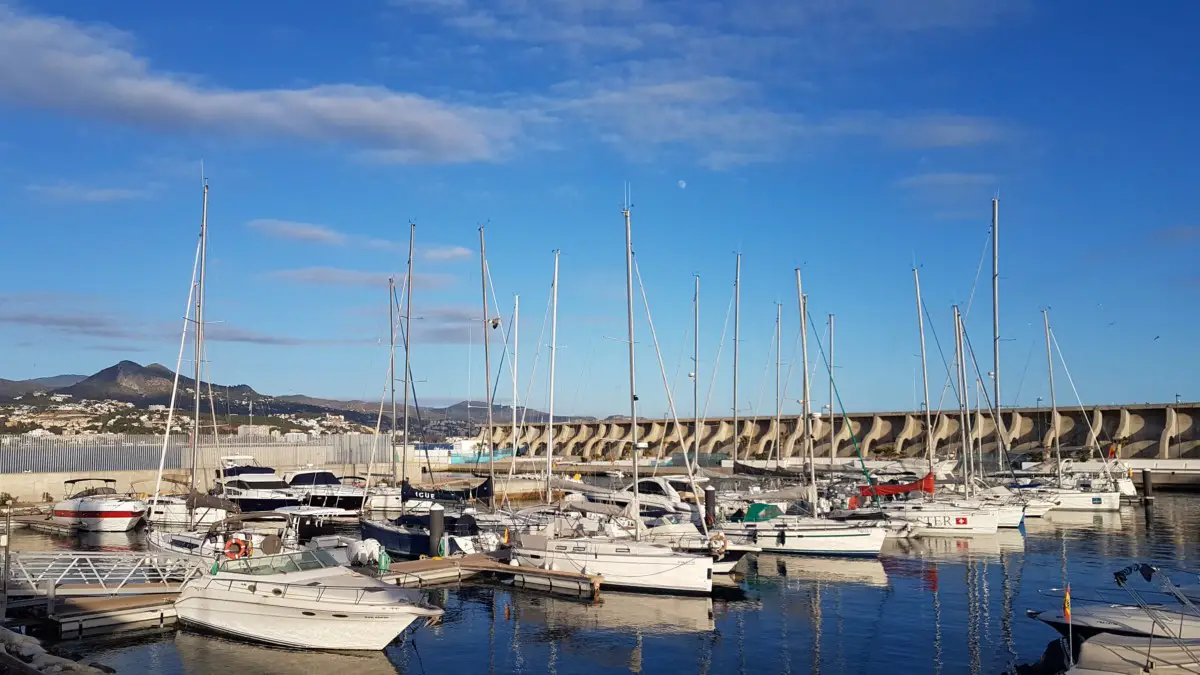As an Amazon Associate, we earn from qualifying purchases. We may also earn commissions if you purchase products from other retailers after clicking on a link from our site.
One thing that still gets me nervous is pulling into dock and parking my boat. You would think a few years into this, I would be untouched by such a mundane task, that is not how it goes, and many of you are just like me. But a major stress reduction came from switching from a monohull to a catamaran, the ease of use from those double engines is amazing, and today’s post is all about that! No more docking-induced anxiety!
To dock a catamaran, you don’t need to use the wheel. Instead, use the throttles to maneuver and position the cat. You can dock either bow or stern first, but stern first gives more visibility to the sides and rear. Take it slow so you can assess conditions and adjust your position as needed.
Don’t let the size of your catamaran intimidate you – it’s easier than you think to maneuver it for docking. Below we’ll sail through some docking techniques once i have explained a bit more about what makes docking a catamaran special.
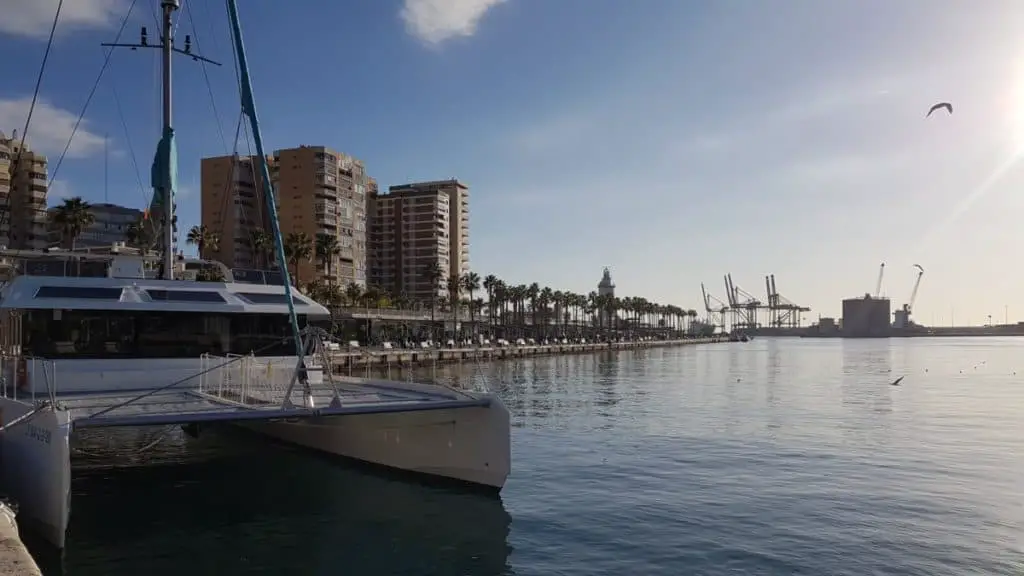
What Is Special About Docking a Catamaran?
If you’re used to handling monohulls, there are several differences you need to understand before docking a cat:
- The twin engines spaced widely apart make a cat extremely maneuverable.
- A cat can rotate 360° on its central axis.
- You can operate a cat at very low speeds, unlike a monohull which needs a minimum speed to maneuver.
- A cat’s low weight means that you can brake, turn and accelerate faster than on a heavy monohull.
- Instead of maneuvering with the wheel and rudder, you control your cat through the two throttles when docking.
All of this comes in handy because a catamaran sits high on the water. This, together with the higher cabin, creates windage. In theory, windage, plus the larger beam of a catamaran, could make docking quite tricky. But that’s where the spaced apart twin engines come into their own.
You can use the two engines together or alone (perfect if one breaks down), and you can use one in the forward position and the other in reverse. This means you have a significant amount of control when maneuvering. That’s especially useful when docking. And that’s what we’ll look at now.
Step one to six is about correctly preparing your catamaran for docking, step seven and onward takes you through different ways of docking.
1. Check the Available Docking Space
It might sound obvious, but the first thing to think about is whether there’s enough space for your catamaran at the dock. Remember, catamarans are sizable beasts, and in busy marinas, space may be at a premium. In most cases, you will need two adjacent spots to fit your vessel in.
If you need to, take an extra lap to scout the perfect spot.
If you’re docking parallel to the dock, you might have to fit between other boats. So, check the gap is large enough to accommodate the length of your catamaran with room to spare.
If you’re docking into a u-shaped slip, check the size of the gap between the two docks that form the slip’s sides. If it’s a shared slip, you’ll have another vessel on one side.
Either way, you’ll need a gap large enough for the width of your catamaran. However, you want room to spare down the sides to accommodate the fenders. The slip’s sides should also be long enough to cater to the length of your catamaran, plus fenders. Check with marina management if your catamaran protrudes at all to make sure this is okay.
Pro tip: Call the marina beforehand and tell them your size and ask if they can show you in!
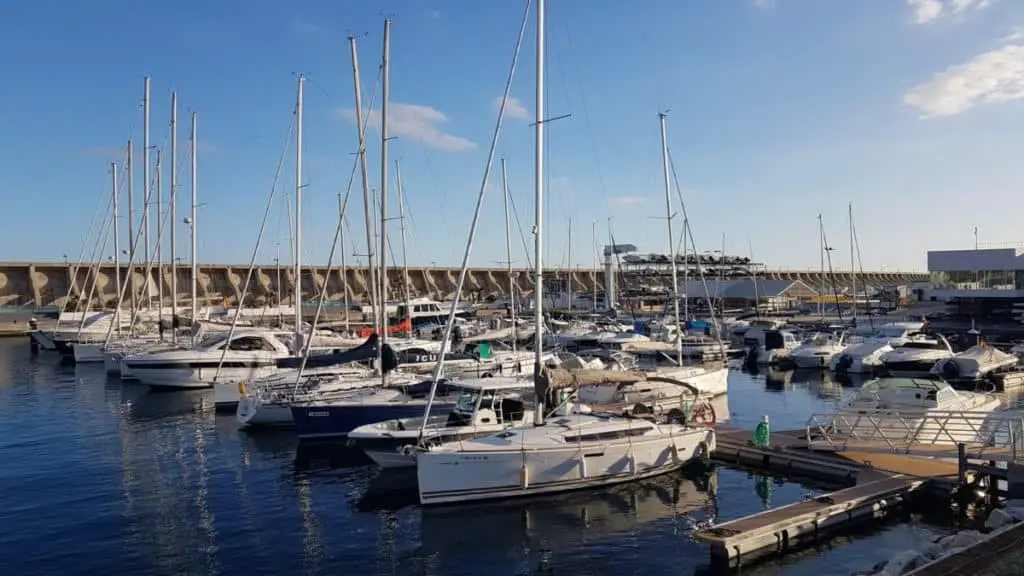
2. Note the Wind Direction and Speed
As mentioned above, a catamaran’s higher hull and cabin create more windage. You have to take this into account when docking in windy conditions, as it can cause your cat to drift off your planned docking course.
With this in mind, you’ll need to figure out if you’ll be docking against the wind or if the wind is blowing you in the direction of the dock.
A great way to check wind direction is to look at the flags in the marina. You’ll see from them which way the wind is blowing relative to the dock. You can also get an idea of wind speed from them. Alternatively, observe the direction in which the wind is moving moored boats.
Wind and currents might affect how you dock or use the throttles to control your catamaran, especially if docking against the wind. We’ll talk more about docking in windy conditions below.
3. Check the Direction and Speed of Any Current
Currents will affect catamaran handling, and as with the wind, knowing the current direction and speed is crucial to docking.
In The Bahamas, we would sometimes have 3-4 knots of current coming into the marina. If you’re going with the current on a monohull, that means you’ll have to go even faster if you want to be able to steer. On a cat, this is much easier to handle!
Entering the Island of Bimin //Gabo
Currents are just as likely as wind to cause you to drift from your intended position as you prepare to dock. Or worse, currents can push you up against the dock or other vessels. So, you might find you’re adjusting your position with the throttles more than if docking in calm conditions.
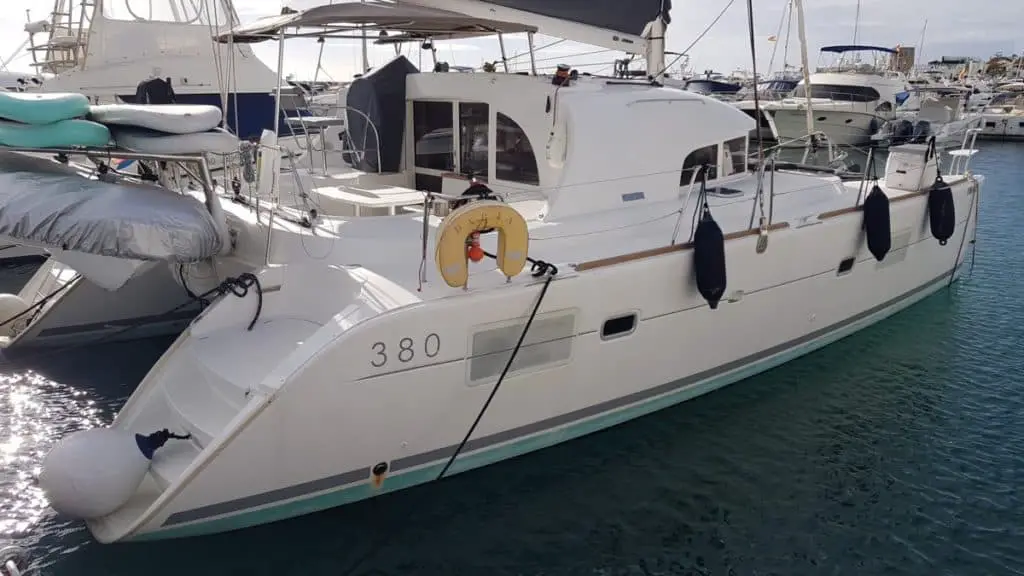
4. Prepare Your Fenders and Your Dingey
Before you dock, you’ll need to ensure you’ve prepared your fenders which will protect your catamaran and the dock from each other. They’ll also help avoid damage if you’re docking next to other boats.
For parallel docking, you’ll need enough fenders to place along the docking side of the catamaran to cushion all potential impact points.
If docking in a three-sided slip, you’ll need fenders on the sides of your catamaran. If reversing into the slip, you’ll also need fenders on the rear.
Have a good look at the docking space before you hang your fenders, and be aware of anything along your docking course that your fenders may snag on. Getting your fenders snagged could cause a loss of control. That’s not a good thing when maneuvering at close quarters.
Also, make sure you either hoist the dinghy onboard or tie it to the side of the cat. You dont want a dingey bouncing around, and you definitely dont want a dingey line stuck in your prop while trying to dock.
And here’s a free lesson I learned the hard way; make sure you put the dinghy in a place where it doesn’t interfere with you moving around the boat. Otherwise, you will, just like I did, have created an obstacle course for yourself!
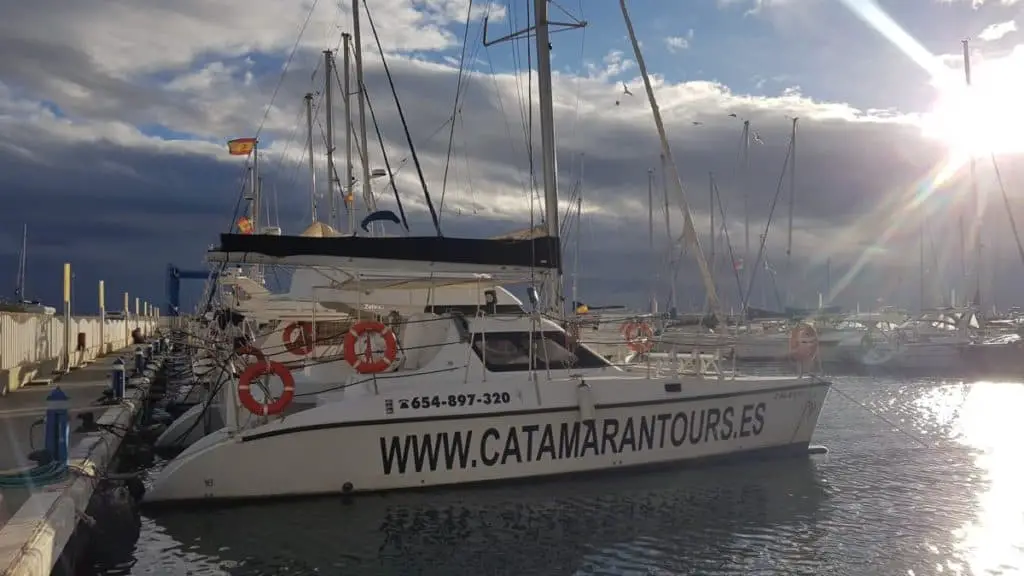
5. Tie the Dock Lines to the Bow and Stern Cleats
Just as important as fenders, you’ll also need to prepare your dock lines which are used to secure your catamaran to the dock. You’ll need dock lines at both the bow and stern.
You may need to secure them to the dock quickly, depending on conditions when docking. So, make sure you’ve prepared them, ready for you or your crew to grab.
ALWAYS keep track of your lines! We didn’t, and we almost sank our boat in the Bimini marina after a rope got tangled in the propeller creating a crooked propeller shaft and a large hole in the hull!
Gabo
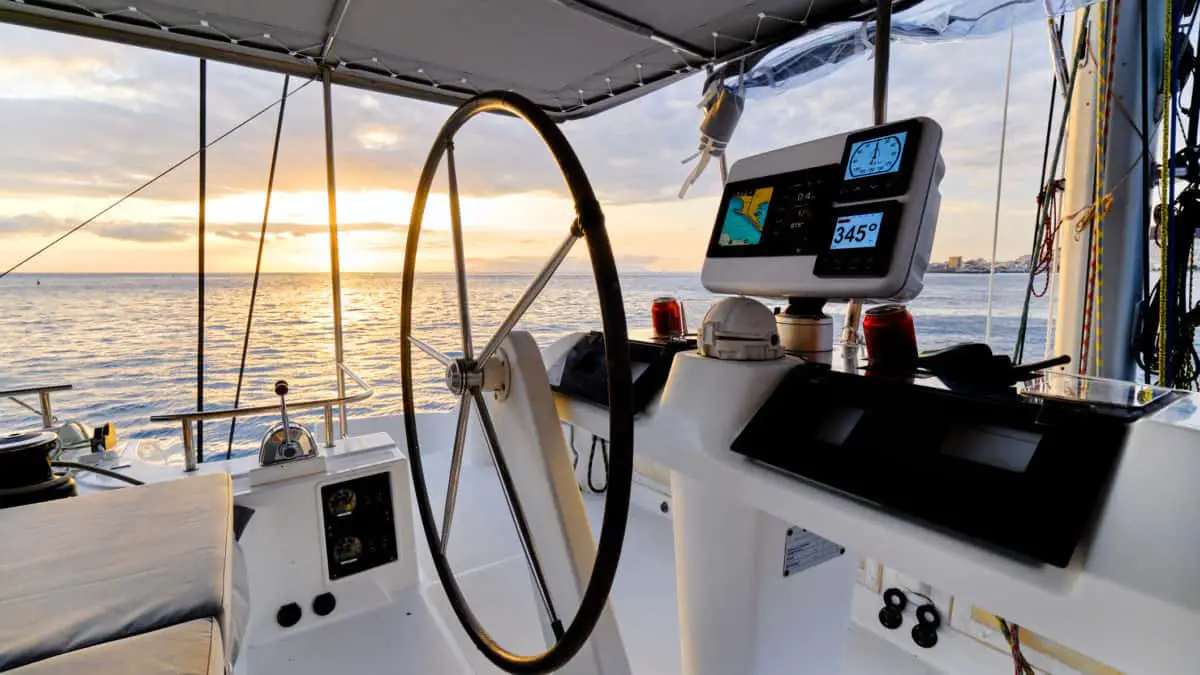
6. Center the Rudders
As mentioned above, you don’t need the wheel to dock a catamaran. At the low speed required for docking your catamaran, the rudder won’t be of much help anyway. So, set the rudders to 0°, or on the centerline.
If you can, lock the wheel in place. Your sole focus should be on the throttles. You can do some more advanced moves that will need you to set your rudders at an angle, but for now, let’s go with the basics!
How To Dock Your Catamaran
Now you’re ready to dock your catamaran, but how you do this depends on several factors. In particular, how you approach the dock will vary depending on whether you’re parallel docking or docking in a slip. It will also depend on whether you’re docking stern first or going in with the bow. As mentioned before, you’ll need to take note of the wind and current direction.
Whether you’re familiar with the dock or not, there’s no need to rush things. If you do, you risk damaging your catamaran or other vessels.
Captain Andros
So, even if you think you’ve got bags of space, the slower you go, the better. It’ll give you time to understand how your catamaran is responding to whatever conditions exist in the marina. You can then make adjustments to the throttles as needed.
Let’s look at different ways to dock your catamaran.
7A. Parallel Docking: Stern First
Docking stern first is often preferable to bow first. That’s because you’ll have more visibility to the sides and rear of the catamaran from your steering position. It’s also better for whoever will be securing the first dock line since it’s easier to alight from the stern end.
Also, if things go awry, it’s more instinctive to shift the throttles forward, to get yourself out of trouble quickly. Doing that can get you into more trouble if you go in bow first.
Pull Up With Your Beam Parallel to Your Berth
Once again, you want to take this slow. Remember, with a catamaran, you don’t need to maintain a certain speed to maneuver it. So, keep your speed to no more than about 1 knot as you approach the dock.
Bring your catamaran’s beam to a position that’s parallel to the docking space but not too close. Aim for a distance of about the width of your catamaran between you and the dock. This will give you room to turn the stern to angle it into the dock while reversing simultaneously.
If there are other docked vessels, pull alongside them, like when you parallel park a car between other vehicles.
Identify a Dock Cleat for Securing the Stern
It’s a good idea to aim for a cleat to which you can attach a dock line to secure the stern. Once you’ve secured the stern, you’ll find it easy to maneuver the catamaran into the correct position to complete docking. Preferably this cleat has been identified already at the dry run mentioned above.
Rotate the Stern
Now you can rotate the stern towards the dock cleat. You’ll approach the dock with the stern angled at about 45°. To rotate, you’ll primarily use the outer engine in reverse to swing the stern in and the bow out as you move backward.
That means, if you’re docking port side, you’ll use the starboard engine in reverse to rotate the catamaran to the correct angle. It’ll be the port engine if you’re docking on the starboard side.
Once you have your angle right, you can put both engines to neutral and let the catamaran coast backward toward the dock. A bit of reverse thrust might be necessary if the wind or current is at your back.
Get the stern near enough to the dock for someone to step off to secure the stern dock line.
Put the Outer Engine Into Forward
Once you’ve secured the stern line to the dock, you can put the outboard engine into the forward position. This will bring the bow around until the catamaran is parallel with the dock. This is an excellent time to make any final adjustments to the positioning of the fenders. You’ll have a better idea at this stage about how to place them for maximum protection.
At this point, the inner engine (the one closest to the dock) will generally stay in neutral. But you might need to run it slightly forward if you find you’re swinging the bow around too fast.
Generally, you’ll probably find yourself switching between both throttles to refine your position to get yourself parallel to the dock.
When you’re almost parallel, put the outer engine to neutral and let momentum complete the move. But, if that momentum is too much, a little forward thrust on the inner engine should halt the bow. Once you’ve got the bow in, secure the bow line to the dock.
You can see the whole process in the following clip between the 1:14 and 3:54 marks. It’s well worth a watch because there are some helpful close-ups of the throttle action throughout the clip:
7B. Parallel Docking: Bow First
While docking stern first is preferable, if you need to dock bow first, here’s what you should do.
Approach the Dock With the Bow at About a 45° Angle
Once again, remember, slow is good when it comes to docking, whichever way you do it. As you approach your berth at the dock, turn the bow at about 45° to the dock. To get the angle, put the outer engine into forward and the inner to neutral. This will turn the bow in while you continue to move forward.
Once you’re around 10ft (3m) from the dock, put both throttles to neutral. Putting the throttles to neutral will slow the catamaran’s forward motion. You want to be doing less than a knot at this point.
Once the bow is closer to the dock, if you have someone who can get ashore from the bow end, they can secure the bow line to the dock. If not, go to the next stage.
Bring the Stern In
With your bow now close to the dock, the next stage is to bring the stern in. If the dock is to the port side, you need to put the starboard engine into reverse and keep the port engine in neutral. If the dock is to the starboard side, keep the starboard engine in neutral and put the port engine in reverse.
Putting the outer engine into reverse will slow the catamaran’s forward movement further. At the same time, it will rotate the stern towards the dock. This rotation will bring the catamaran parallel to the dock.
Again, this is where you can make final adjustments to the position of the fenders.
Tie the Stern and Bow Dock Lines
Once the stern is close enough, you can get both the stern and bow lines cleated. With the stern secured, hold the catamaran parallel to the dock, using the throttles if necessary.
The stern dock line should limit forward movement. But a slight forward thrust on the outboard engine will help keep the bow in if it starts drifting out before you get the bow secured.
7C. Parallel Docking: Wind or Current Pushing You In
If you have wind or currents pushing you toward the dock, you can use their directional effect when parallel docking. And it’s best to dock stern first to avoid the bow getting blown in.
Position your catamaran parallel to the dock. Again, try to line up the stern with a cleat to make it easier to secure the stern line quickly. Once parallel to the dock, let the wind or current push you in the rest of the way. You can use the engines as needed to keep your catamaran parallel if the wind or current throws it off its position.
Once you’ve secured the stern dock line, hold the catamaran in position with a few forward revs on the outer engine. That will keep the bow in so you can secure the bow dock line.
7D. Parallel Docking: Wind or Current Pushing You Away
Parallel docking in wind or currents pushing you away from the dock may sound hard, but the control you have with the dual engines will help. Your priority for docking in these conditions is to secure the stern, as this will help get the bow in against the wind or current.
Go in stern first, aiming for a cleat and use the engines to keep the stern angled at about 45° as you reverse toward the dock. Don’t be surprised if you need to make more adjustments with the throttles than on a calm day.
Once the stern is close enough, you can get the stern line secured to the dock. When that’s done, move the throttles forward to bring the bow in against the wind. The stern line will limit the catamaran’s forward movement. This, combined with the forward thrust from the engines, will pull the bow in.
The following video demonstrates bow and stern first docking. In the latter, the wind is pushing the cat away from the dock. The footage includes drone-eye views, so you really get to see what’s happening:
7E. Docking into a Slip
In many marinas, you’ll find u-shaped slips with parallel docks on either side in which you can berth your catamaran. So, instead of docking parallel, you’ll reverse into the slip.
Reversing into a slip has the benefit of making it that much easier to leave, especially when there’s limited space in the marina. However, you’ll need to do a bit more maneuvering than if you go in bow first.
So, here’s how to do it.
Take Up a Position in Front of the Slip
Reversing into a slip is a reasonably easy maneuver. Once you’re in front of the slip, you’ll need to rotate your catamaran on the spot to get your stern facing the slip.
Remember, you can rotate a catamaran around its central axis by putting one throttle in reverse and the other forward by equal amounts.
You can see this rotation maneuver in the following clip:
Reverse Into the Slip Using Both Throttles
Once you’ve rotated your catamaran so the stern faces the slip, you can put both throttles slightly into reverse. This will move you straight back into the slip.
Don’t go overboard on the reverse thrust here. In fact, you’ll probably want to switch from slight reverse to neutral on the throttles, so you end up coasting into position.
You might need to tinker with your position as you’re moving back. It’s just as you might make minor steering adjustments when reversing a car to straighten it out or keep it straight.
Conclusion
So, that’s a step-by-step guide to how to dock a catamaran in various conditions. While the conditions you might encounter will vary, the control that dual engines spaced widely apart gives you will help you deal with them.
The crucial thing is to take it slow, to give yourself time to assess the conditions, and adjust your throttles as needed. Do that, and docking a catamaran will be plain sailing. Print this page and take it with you on your next sail and before you dock use it as a checklist to gain some confidence and trust me the anxiety will disappear!
Enjoy !
Sources
- Marsh Marine Design: Wetted Surface Area
- Wikipedia: Beam (nautical)
- The Naval Arch: The Four Important Factors for a Ship’s Windage Area Calculations
- Renegar Construction: The Difference Between Boat Slips and Docks: Which is Right for Your Lake House?
- SVB24: Find the Right Fender for Your Boat
- Summerland Yacht Club: Recommended Dock Line Practices
- Youtube: How to Park Your Catamaran: Docking Part 2
- Youtube: Catamaran Docking Part 2
- Yachting World: Catamaran Sailing Techniques: Everything You Need to Know

